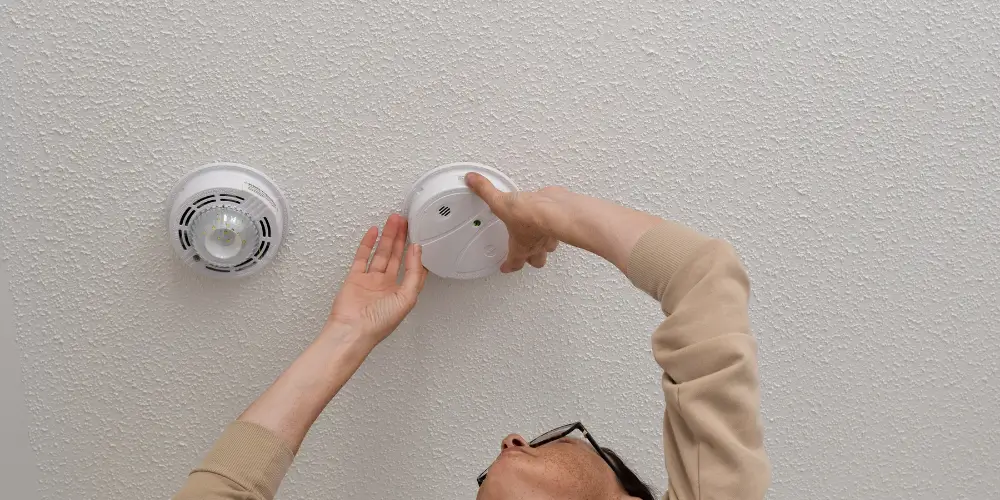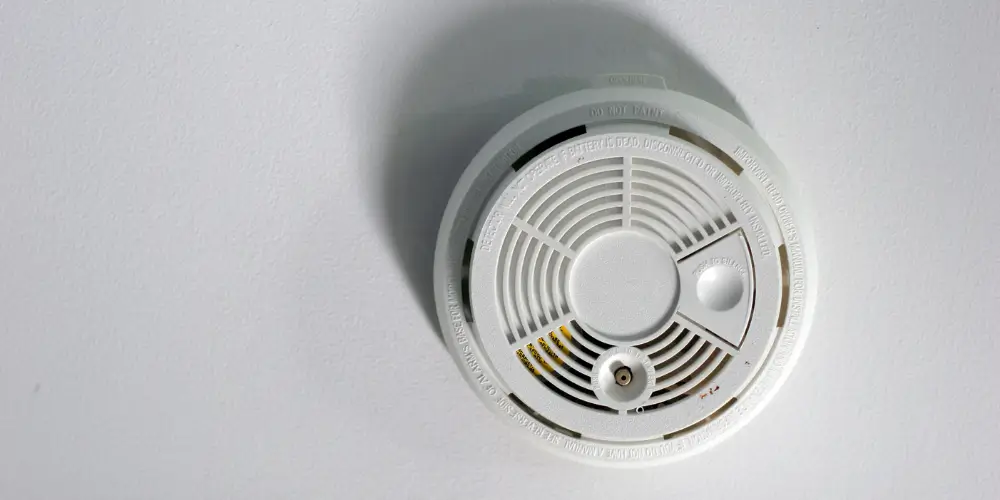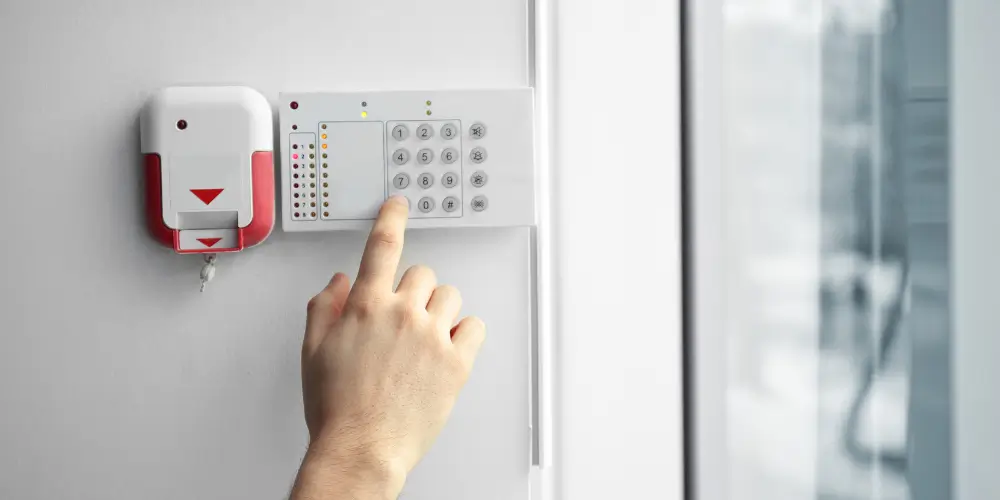The Electrical Installation Condition Report (EICR) designates a C1 code for the absence of smoke alarms in a property, highlighting an immediate danger requiring urgent attention to meet compliance standards. This code serves as a critical safety indication, reflecting non-conformity with UK Building Regulations, which mandate smoke alarms on every occupied floor. The classification of C1 emphasises the exigent risk to occupant safety due to the lack of early fire detection facilities. Addressing such glaring infractions not only mitigates potential legal repercussions for property owners but greatly enhances occupant safety measures. Further insights can deepen the understanding of how EICR codes influence safety compliance strategies in properties.
Key Takeaways
- The EICR code for no smoke alarms is C1, indicating immediate danger.
- A C1 code requires urgent action to install smoke alarms for compliance.
- Addressing a C1 code reduces the risk of fire-related fatalities and injuries.
- Compliance with the C1 code enhances safety and meets legal requirements.
- Regular inspections can prevent the assignment of a C1 code by maintaining proper smoke alarm installations.
Table of Contents
Understanding EICR Codes
An Electrical Installation Condition Report (EICR) is a formal document generated following a thorough assessment of a building’s electrical systems to guarantee they meet the required safety standards.
The primary objective of EICR codes, including those specific to smoke alarms, is to identify any deficiencies that may pose potential safety hazards.
What is an EICR?
EICR, or Electrical Installation Condition Report, is a formal document generated by a qualified electrician or approved contractor that assesses the safety of electrical installations within a property. This assessment is essential for understanding the EICR basics, a foundational component in ensuring that all electrical systems meet current safety standards.
Electrical inspections, as part of the EICR, involve a thorough examination of the electrical circuits, equipment, and associated materials. This includes checking for wear and tear, identifying any potential electric shock risks, and making sure that the installation has not been altered in a manner that could compromise safety.
The primary aim is to guarantee compliance with the prevailing wiring regulations and standards.
Compliance guidelines within the EICR framework detail the conditions and standards required for electrical systems. These guidelines serve as a benchmark for risk assessments conducted during inspections, helping to identify areas that do not meet legal safety requirements.
The assessment categorises risks with specific codes, which inform the property owner of necessary remedial actions.
Through its structured approach, the EICR guarantees that electrical installations do not pose any undue risk to occupants, aligning with statutory requirements for electrical safety.
Purpose of EICR Codes
Why are EICR codes essential for property safety?
Electrical Installation Condition Reports (EICR) codes are critical regulatory tools designed to enforce safety standards in residential and commercial properties. They serve as systematic procedures for evaluating electrical installations against the national standards for the safety of electrical systems. The primary purpose of these codes is to identify any deficiencies that could pose safety hazards, thereby preventing potential electrical fires and guaranteeing that the installations are in a condition suitable for continued use.
EICR codes are pivotal for integrating smoke alarm systems. Compliance with smoke alarm standards is a key component of these codes, highlighting the necessity for proper installation and maintenance to safeguard occupants from fire risks.
Additionally, the implications of EICR evaluations extend beyond mere compliance; they involve educating property owners and tenants on their responsibilities towards maintaining these safety measures. This promotes a culture of fire safety education and proactive prevention strategies.
Furthermore, compliance challenges often arise due to the evolving nature of electrical standards and tenant turnover. Addressing these challenges through rigorous EICR evaluations ensures ongoing adherence to safety norms, thereby mitigating risks associated with electrical faults and enhancing overall property safety.

Importance of Smoke Alarms
Smoke alarms play a vital role in fire safety by providing early warning of fire, thereby allowing for timely evacuation and potentially saving lives.
In London, the installation and maintenance of these devices adhere to national safety guidelines and meet specific legal requirements that vary by area and building type.
Understanding these requirements is essential for complying with them and enhancing the protective measures afforded by smoke alarms under the Electrical Installation Condition Report (EICR) standards.
Role in Fire Safety
A vast majority of residential fire-related fatalities occur in homes without functioning smoke alarms. This statistic underscores the critical role smoke alarms play within the broader spectrum of fire safety mechanisms. Integrating these devices into thorough fire prevention strategies greatly enhances the protective measures against the often devastating impact of residential fires.
Smoke alarms act as the first line of defence, providing early warning signals that can facilitate timely evacuation and emergency response. Effective community awareness programs are pivotal in educating homeowners and residents about the necessity of regular maintenance of these devices to guarantee their operational integrity.
Additionally, emergency response training often incorporates the function and importance of smoke alarms, equipping individuals with the knowledge to react swiftly and safely during a fire incident.
Residential safety audits often emphasise the placement and functionality of smoke alarms, integrating them as a key component of home safety evaluations. Advances in technology integration solutions have further improved the effectiveness of smoke alarms, with features such as interconnected systems that alert all occupants simultaneously and smart alarms that can notify homeowners remotely.
Consequently, smoke alarms are indispensable tools in the architecture of residential fire safety, greatly mitigating risks and enhancing protective responses.
Legal Requirements in London
Understanding the legal requirements for smoke alarms in London is essential for guaranteeing compliance and enhancing fire safety in residential properties. The regulations mandate that all landlords install smoke alarms on every floor of their properties where a room is used wholly or partly as living accommodation. This requirement is part of broader fire safety compliance measures aimed at reducing risks and safeguarding occupants.
| Key Aspect | Detail | Implication |
| Installation | Mandatory on every occupied floor | Non-compliance can lead to penalties |
| Maintenance | Regular checks required | Guarantees operational effectiveness |
| Awareness | Must inform tenants of installations | Increases safety equipment utilisation |
Landlord responsibilities extend beyond mere installation to guaranteeing that all safety equipment, including smoke alarms, is maintained and functional. Tenants, on the other hand, must be made aware of these installations and their operational status. This dual responsibility guarantees a high level of tenant awareness and contributes to overall safety in residential settings. Additionally, adherence to smoke alarm regulations is not merely a legal formality but a critical component of fire safety management, demanding precision and vigilance from all stakeholders involved.

EICR Codes Related to Smoke Alarms
Specific codes in the Electrical Installation Condition Report (EICR) are vital for identifying the presence and functionality of smoke alarms within a property.
Common codes such as C1, indicating immediate danger due to missing smoke alarms, and C2, suggesting potential danger, are assigned based on the absence or malfunction of these devices.
Recognising and addressing these codes is essential for ensuring compliance with safety standards and reducing fire-related risks.
Identifying Missing Smoke Alarms
Identifying missing smoke alarms within residential or commercial properties is a critical aspect of the Electrical Installation Condition Report (EICR). The assessment meticulously examines the presence and functionality of smoke alarms, which are indispensable for meeting regulatory compliance and guaranteeing occupant safety.
This process involves a thorough inspection, not only to check the existence but also to evaluate the adequacy of smoke alarm installation in accordance with the latest standards and technological advancements in alarm technology.
Professionals conducting these inspections are required to have a deep understanding of various smoke alarm systems and their installation parameters. This knowledge guarantees that the systems are appropriately integrated into the building’s electrical network and can provide reliable warnings in case of fire.
Additionally, EICR inspectors are also tasked with verifying that the property has undergone recent residential compliance checks and adheres to preventative safety measures.
The integration of fire safety education into the inspection process empowers property owners with the essential knowledge to maintain and periodically test smoke alarm systems, guaranteeing their operational integrity between scheduled reviews.
This all-encompassing approach underscores the importance of proactive safety measures in fire prevention and protection strategies.
Common Codes Assigned
During Electrical Installation Condition Reports (EICR), specific codes are assigned to identify and categorise the status of smoke alarms in properties. These codes reflect the urgency and nature of the issues found, influencing both the safety outcomes and the EICR implications for property compliance. The coding system is essential for delineating the severity of risks and prescribing necessary remedial actions to enhance fire safety education.
| Code | Description | Implication |
| C1 | Danger present, immediate risk | Urgent action required; non-compliance with regulations |
| C2 | Potentially dangerous | Remedial action is needed soon to guarantee the safety |
| C3 | Improvement recommended | Advised upgrade to enhance safety technology |
| FI | Further investigation required | Unclear issues; more detailed assessment needed |
| NA | Not applicable/no issues found | Compliant, no action needed |
Understanding these codes is pivotal in maintaining Building compliance and guaranteeing the effective deployment of appropriate Smoke alarm types. The technical allocation of these codes enables a structured approach to managing fire risks. It underscores the critical role of advanced safety technology in residential and commercial settings. Each code not only dictates immediate action but also contributes to a broader understanding of fire safety protocols and prevention strategies.
Safety Implications
The absence of smoke alarms greatly elevates the risk of injury or fatality in residential fires by delaying the detection and response times.
Compliance with EICR codes for smoke alarms directly correlates with enhanced occupant safety, reducing potential harm in fire incidents.
It is critical to evaluate the impact of these regulations on both the immediate and long-term safety outcomes for building occupants.
Risks of No Smoke Alarms
The lack of smoke alarms in residential or commercial buildings greatly increases the risk of fatalities and injuries in the event of a fire. The absence of these critical devices means that the detection of smoke and early signs of fire is considerably delayed, reducing the time available for evacuation and emergency response.
This oversight can exacerbate fire hazards, transforming manageable incidents into catastrophic losses.
From an insurance perspective, buildings without smoke alarms are seen as high-risk properties. This perception can lead to increased premiums or denial of coverage, placing a financial burden on homeowners and commercial property owners.
Additionally, the lack of smoke alarms may contravene local safety regulations, potentially leading to legal repercussions, fines, and invalidated insurance claims.
Homeowner responsibilities extend beyond property maintenance to include ensuring the safety and welfare of occupants. Community awareness programs and regulatory bodies emphasise the installation of smoke alarms as a fundamental safety measure.
Similarly, landlords bear a critical duty to install and maintain smoke alarms to safeguard tenant safety. Failure to do so not only endangers lives but also exposes property owners to liability and potential litigation.
Impact on Occupant Safety
Ensuring the presence of functional smoke alarms in buildings greatly enhances the safety of occupants by providing early warning in case of fire, thereby allowing more time for evacuation. This measure considerably impacts emergency preparedness by fostering an environment where timely and informed responses to fire incidents are possible.
Implementing smoke alarms enhances occupant awareness, which correlates directly with the effectiveness of evacuation procedures. This reduces potential casualties and injuries in emergencies.
Incorporating regular fire drills and safety education into the building management protocols further leverages the presence of smoke alarms. These practices educate occupants on the ideal response strategies during fire incidents, which are critical in minimising panic and confusion.
A robust risk assessment should identify the absence of smoke alarms as a major deficiency, highlighting the building’s increased vulnerability to fire-related accidents.
Moreover, smoke alarms play a pivotal role in the systematic approach to safety by serving as the initial alert system in a layered emergency response framework.
Their integration with other safety measures, such as fire extinguishers and clear, accessible evacuation routes, forms a thorough safety network that considerably mitigates the risks associated with fires.
Regulatory Standards
The UK Building Regulations specify stringent criteria for the installation and maintenance of smoke alarms to guarantee safety and compliance.
Landlords are particularly mandated to adhere to these standards, guaranteeing that all residential properties meet the Electrical Installation Condition Report (EICR) requirements.
This not only safeguards tenants but also legally protects the landlords from potential liabilities.

UK Building Regulations
Within the framework of UK Building Regulations, specific standards are mandated for the installation and maintenance of smoke alarms in residential and commercial buildings to guarantee safety and compliance.
These regulations are designed to enhance building safety and secure a high standard of fire prevention. Compliance with these standards is not merely a recommendation but a legal requirement that must be rigorously followed to minimise risk and protect occupants.
The technology behind smoke alarms must meet specified criteria that support early detection and reliability in a variety of building layouts and usage patterns.
The regulatory framework is robust, requiring that all installed alarms be systematically tested and maintained to remain effective in alerting occupants of fire hazards. This rigorous approach helps mitigate potential fire risks, safeguarding both property and lives.
Additionally, while building owners and managers typically have the primary responsibility for installing and maintaining these devices, tenants also have certain responsibilities to secure the functionality of smoke alarms.
This shared responsibility model is vital for continuous operational effectiveness and forms an integral part of overall regulatory compliance strategies in fire safety.
Compliance for Landlords
Under UK Building Regulations, landlords are responsible for guaranteeing that all smoke alarms in their properties meet strict compliance standards. This entails not only the installation but also the regular maintenance and testing of these devices to ascertain functionality and safety. Landlord responsibilities extend to providing compliance training and guaranteeing tenant awareness of safety procedures and the proper use of installed smoke alarms.
Property inspections play an essential role in maintaining these safety standards. Regular checks are mandated to verify that smoke alarms are operational and correctly positioned according to legal requirements. These inspections must be documented meticulously to provide evidence of compliance should disputes arise or regulatory audits be conducted.
The following table outlines key aspects of compliance for landlords regarding smoke alarms:
| Aspect | Description |
| Installation | Guarantee proper installation as per manufacturer’s guidelines |
| Maintenance | Regular checks and replacements as necessary |
| Documentation | Maintain records of inspections and maintenance activities |
| Education | Inform tenants about smoke alarm testing and evacuation procedures |
Adherence to these standards not only fulfils legal obligations but greatly enhances tenant safety, potentially saving lives in the event of a fire.
Identifying Non-Compliance
Identifying non-compliance in the context of smoke alarm installation involves recognising key indicators, such as the absence of required smoke alarms in specified locations.
Inspectors play an essential role in this process. They use detailed checklists aligned with the EICR code to document any discrepancies or violations systematically.
This method guarantees that all findings are reported accurately, facilitating timely enforcement and compliance rectification.
Signs of Missing Smoke Alarms
Recognising the absence of smoke alarms in residential properties is essential for ensuring compliance with safety regulations. Identifying signs of missing alarms involves a systematic assessment of both visible installations and documentation. The absence is initially suggested by a lack of physical devices in critical areas defined by building codes, such as bedrooms, living rooms, and nearby kitchen spaces.
Detection systems serve as the frontline in fire prevention, and their non-existence can often be correlated with outdated or missing inspection records. A professional evaluation should include scrutinising property maintenance logs for gaps in safety device updates or installations.
Another indicator is the absence of wiring or mounting brackets typically used for smoke alarms, which can be spotted during a thorough physical inspection of the premises.
Safety awareness campaigns consistently emphasise the importance of functional alarms, and any alternative solutions, such as heat detectors or integrated fire systems, should also be documented and verified. If such alarm alternatives are not present or if their functionality does not align with the latest safety standards, this, too, is a critical non-compliance issue.
Consequently, the technical evaluation for missing smoke alarms is a multifaceted process that focuses on both physical evidence and compliance documentation.
How Inspector Report Issues
When inspectors identify non-compliance concerning smoke alarm installations during property evaluations, they follow a structured protocol to document and report these issues. This process is underpinned by rigorous inspector training, guaranteeing that each assessment adheres to established reporting protocols. Inspectors utilise standardised inspection checklists, which guide them through an all-encompassing review of smoke alarm systems, noting any deviations from legal and safety standards.
Here’s a breakdown of their process:
| Stage | Action |
| Initial Assessment | Verify the presence and placement of alarms. |
| Detailed Inspection | Check functionality and compliance with codes. |
| Documentation | Record findings and evidence of non-compliance. |
| Reporting | Submit a detailed report to the appropriate authority. |
Each step is vital and reflects the inspector’s responsibilities to guarantee safety and regulatory compliance. Common findings include improperly located alarms, expired units, or faulty installations, which are meticulously documented. The final report is a significant document that communicates the level of compliance to property owners and regulatory bodies, influencing necessary remediations to uphold safety standards. This technical and analytical approach is indispensable for maintaining the integrity and efficacy of safety inspections.

What EICR code is given for missing smoke alarms?
In the context of Electrical Installation Condition Reports (EICR), the absence of smoke alarms in a property typically warrants a C3 code, indicating that the issue is considered to be an improvement recommendation. This designation underscores the significance of adhering to smoke detection standards, which are essential for guaranteeing timely alerts in the event of a fire, thereby safeguarding both life and property.
Missing alarms have severe implications, as they directly compromise the safety mechanisms designed to alert occupants to the early stages of fire. This lack of compliance not only poses a risk to physical safety but also impacts the legal standing of property managers.
Fire safety regulations explicitly mandate the installation of smoke alarms in specific areas of residential and commercial buildings. The absence thereof not only contravenes these statutory requirements but also exposes landlords to potential legal repercussions, including fines and heightened liability in the event of fire-related incidents.
Furthermore, landlord responsibilities extend beyond mere compliance with fire safety norms; they encompass a duty to guarantee ongoing operational functionality of safety installations. Regular maintenance checks and timely updates to fire safety equipment are essential.
Additionally, tenant awareness plays a pivotal role. Tenants must be educated about the functionality and necessity of smoke alarms, guaranteeing they understand the procedures to follow should these alarms indicate a fire. This educational aspect forms a vital component of fire safety strategies, emphasising a proactive approach to disaster prevention and management.
Is it possible to fail an EICR for no smoke alarms?
While a C3 code is given for missing smoke alarms as an improvement recommendation, it is important to note that the absence of smoke alarms does not, by itself, cause an EICR to fail. However, the broader implications of non-compliance with smoke alarm regulations can greatly impact a property’s overall safety and legal standing.
EICR, or Electrical Installation Condition Report, assesses the safety of electrical systems and is a vital document, particularly for landlords. Failure to install smoke alarms does not directly lead to an EICR failure. Still, it raises serious concerns under fire safety standards that could indirectly influence the EICR outcomes.
Landlords must understand that adhering to smoke alarm regulations is part of their fundamental responsibilities. These regulations are designed to enhance tenant safety and provide early warnings in the event of a fire, thus reducing the risk of fatalities and injuries.
Tenant awareness is also important. Tenants should be informed about the significance of having functional smoke alarms and should verify that these are tested regularly. The synergy between tenant awareness and landlord responsibilities creates a safer living environment.
Accordingly, the EICR implications of missing smoke alarms extend beyond the electrical certification process. They touch on broader safety issues and compliance with legal standards that govern residential and commercial properties.
Confirming that smoke alarms are installed and maintained is not just about passing an EICR but about upholding safety and legal obligations that protect both the property and its occupants.

EICR Codes for No Smoke Alarm
depending on the level of risk observed, various codes may be applied when evaluating the absence of smoke alarms in an Electrical Installation Condition Report (EICR),
A C3 code suggests that smoke alarms should be installed for enhanced safety. In contrast, a C2 code indicates a potential danger that necessitates remedial action to prevent harm.
More severe assessments, such as C1 or F1, imply the presence of immediate danger or the need for further investigative measures to fully assess the risks associated with the lack of smoke alarms.
C3 (Improvement Recommended)
Why should a property’s electrical inspection condition report (EICR) designate a C3 code when no smoke alarms are present? The C3 code, indicating that enhancement is recommended, serves as a critical advisory in the context of fire safety standards and regulations. This classification underscores the absence of smoke alarms as a considerable oversight, yet not imminently dangerous under current conditions, allowing for planned rectifications.
The integration of advanced smoke alarm technology is essential for enhancing occupant safety and minimising risks associated with fire emergencies. Modern smoke alarms equipped with interconnected systems and smart features provide robust protection and quicker emergency responses.
Implementing thorough fire safety education and tenant awareness programs can profoundly impact the effectiveness of these devices, guaranteeing that occupants are well-informed about operational procedures and maintenance.
Furthermore, clearly outlined alarm installation guidelines facilitate the correct placement and functionality of smoke alarms, optimising their efficacy. Emergency response planning, paired with these installations, guarantees structured and swift action in the event of a fire, considerably reducing potential hazards and promoting safety.
Thus, the designation of a C3 code not only highlights an area for improvement but also catalyses the adoption of essential safety measures within the property.
C2 (Potential Danger)
If an Electrical Inspection Condition Report (EICR) reveals the absence of smoke alarms in a property, a C2 code, which indicates potential danger, must be assigned. This coding reflects a situation where the risk of fire-related incidents is considerably increased due to the lack of early detection and alert systems.
The absence of these essential devices does not yet constitute an immediate threat, as would be indicated by a C1 code. Still, it considerably compromises safety protocols and emergency response planning.
The effectiveness of smoke alarms in reducing casualty and fatality rates in residential fires is well-documented, making their installation a critical aspect of home safety. Alarm installation guidelines specify strategic placement and maintenance routines to maximise functionality and reliability.
Homeowners must adhere to these guidelines to guarantee optimal protection and compliance with safety standards.
Moreover, fire safety education plays an important role in reinforcing the significance of having functional smoke alarms. It empowers residents with knowledge of how to respond in case of an emergency and the maintenance required to keep the alarms operational.
C1 (Danger Present)
In cases where an Electrical Inspection Condition Report (EICR) identifies the complete absence of smoke alarms in a property, a C1 code is issued, indicating the presence of immediate danger. This classification underscores a critical failure in fire hazard awareness and a breach in tenant safety responsibilities. The absence of such essential safety devices not only compromises the integrity of emergency response planning but also flags severe non-compliance with building regulations.
To rectify this perilous oversight, stringent alarm installation guidelines must be promptly adhered to. The installation process should comply with the latest standards and be verified through thorough building compliance checks. These checks guarantee that smoke alarms are ideally placed to detect smoke and fire swiftly, providing inhabitants with the necessary lead time to evacuate safely in the event of a fire.
Moreover, property owners and managers must understand that the installation of smoke alarms is not a mere formality but a critical component of a broader safety ecosystem. This system includes regular maintenance checks and tenant education on emergency response procedures.
Guaranteeing these measures can drastically reduce the risks associated with fire incidents, safeguarding both human lives and property assets.
F1 (Further Investigation)
While a C1 code categorically signals an immediate hazard due to the absence of smoke alarms, an F1 code under the Electrical Inspection Condition Report (EICR) serves a different purpose.
The F1 designation implies that further investigation is necessary to accurately assess the fire risk associated with the current state of smoke alarm systems within a property. This code does not immediately indicate a danger. Still, it suggests potential issues that require a deeper analysis to guarantee compliance and safety.
In the context of F1 findings, several critical actions are typically recommended:
- Compliance Checks: Verifying that existing installations meet the latest safety standards.
- Alarm Placement Analysis: Confirming ideal placement and functionality of smoke alarms to maximise their efficacy in alerting tenants.
- Safety Audits: A thorough review of all electrical systems related to fire safety, including but not limited to smoke alarms.
- enant Awareness Programs: Initiate educational sessions to inform tenants about fire safety measures and the importance of maintaining smoke alarm systems.
- Detailed Inspection of Wiring: Identifying any underlying issues that could compromise the effectiveness of smoke alarms.
Addressing these points during an F1 follow-up enhances tenant safety and guarantees legal compliance with fire safety regulations.
Environmental Considerations
Evaluating the environmental impact of smoke alarms is essential when considering their EICR code.
The energy efficiency of modern smoke alarms plays a critical role in reducing buildings’ overall energy consumption, aligning with broader sustainability objectives.
Additionally, implementing sustainable safety practices, such as using recyclable materials and reducing hazardous substances in alarm manufacturing, further the environmental agenda while maintaining safety standards.

Energy Efficiency of Modern Alarms
Modern smoke alarms have been meticulously engineered to maximise energy efficiency, an important factor for both environmental sustainability and operational cost reduction. The integration of energy-saving technologies in these devices guarantees that they consume less power, which is vital in minimising their environmental footprint.
Advances in battery efficiency also contribute greatly to their improved performance, allowing for longer operational periods without the need for frequent replacements. This not only reduces waste but also lowers the resource consumption associated with manufacturing new batteries.
- Smart Alarm Systems: Incorporates sensors that adjust sensitivity based on ambient conditions, reducing false alarms and saving energy.
- Eco-Friendly Materials: Utilises recycled and biodegradable components to decrease environmental impact.
- Energy Saving Technologies: Features like LED indicators and low-power wireless communication enhance efficiency.
- Battery Efficiency: Advanced lithium batteries offer extended life spans and better performance, minimising replacement frequency.
- Sensor Advancements: Enhanced sensor technology improves detection accuracy, optimising power usage and reducing unnecessary activations.
These innovations enhance the functionality of smoke alarms and align with the growing demand for sustainable and efficient safety solutions in residential and commercial environments.
Sustainable Safety Practices
Building upon the advancements in energy-efficient technologies and materials in modern smoke alarms, it is equally important to reflect on broader environmental strategies within the domain of fire safety.
The integration of sustainable materials in the manufacturing of smoke alarms not only minimises environmental impact but also enhances the lifecycle and disposal processes associated with these devices. Utilising biodegradable or recyclable components can greatly reduce waste and facilitate a more sustainable production cycle.
Eco-friendly designs in smoke alarm technology should prioritise not only the functionality and safety features but also incorporate renewable energy sources to power the devices. The adoption of solar panels or other small-scale renewable energy options can decrease reliance on non-renewable power sources, thereby reducing the carbon footprint of residential and commercial buildings.
Moreover, pursuing green certifications can serve as a benchmark for industry standards, ensuring that products meet rigorous environmental and safety criteria. Such certifications can guide consumers towards making environmentally responsible choices, promoting wider adoption of green technologies in fire safety.
These practices, focused on sustainable materials, eco-friendly designs, renewable energy, green certifications, and waste reduction, are essential for fostering a holistic approach to environmental stewardship in the fire safety industry.
Frequently Asked Questions
How Often Should Smoke Alarms Be Tested in a Home?
Smoke alarm maintenance is essential to navigate the labyrinth of home safety. Testing should be conducted monthly, batteries replaced annually, and strategic alarm placement per safety regulations guaranteed to guarantee peak functioning and compliance.
Can I Install a Smoke Alarm Myself?
Yes, you can install a smoke alarm yourself by adhering to DIY smoke alarm installation guidelines, ensuring compliance with safety regulations, and following alarm maintenance tips to enhance fire prevention strategies effectively.
What Type of Smoke Alarm Is Most Effective?
The most effective smoke alarms incorporate photoelectric and ionisation technologies. Combination alarms offer robust detection of both smouldering and flaming fires, while smart alarms provide enhanced features and connectivity. Consider long-lasting battery types for reliability.
Are There Different Requirements for Smoke Alarms in Commercial Properties?
Manoeuvring through the labyrinth of commercial alarm regulations reveals specific fire safety standards. Each property type demands tailored installation guidelines and maintenance responsibilities, ensuring a robust defence against the ever-present spectre of fire.
How Long Do Smoke Alarms Typically Last Before Needing Replacement?
A smoke alarm’s lifespan typically extends up to 10 years. Replacement indicators include frequent false alarms and failure to test correctly. Battery maintenance, environmental factors, and advancements in alarm technology can also influence replacement timelines.

